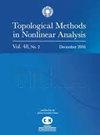Multiplicity of positive solutions for a Kirchhoff type problem without asymptotic conditions
IF 0.7
4区 数学
Q2 MATHEMATICS
引用次数: 0
Abstract
In this paper, we are concerned with the multiplicity of positive solutions for the following Kirchhoff type problem \[ \begin{cases} -\bigg({\varepsilon}^2a+{\varepsilon}b\int_{\mathbb{R}^3} |\n u|^2dx\bigg)\Delta u+u=Q(x)|u|^{p-2}u, & x\in\mathbb{R}^3,\\ u\in H^1\big(\mathbb{R}^3\big), \quad u> 0, & x\in\mathbb{R}^3, \end{cases} \] where $\varepsilon> 0$ is a small parameter, $a,b> 0$ are constants, $4< p< 6$, $Q$ is a nonnegative continuous potential and does not satisfy any asymptotic condition. Combining Nehari manifold and concentration compactness principle, we study how the shape of the graph of $Q(x)$ affects the number of positive solutions.无渐近条件的Kirchhoff型问题正解的多重性
本文研究了下述Kirchhoff型问题\[\begin{cases}-\bigg({\varepsilon}^2a+{\varepsilon}b\int_{\mathbb{R}^3} |\n u|^2dx\bigg)\Delta u+u=Q(x)|u|^{p-2}u, & x\in\mathbb{R}^3,\\u\in H^1\big(\mathbb{R}^3\big), \quad u> 0, & x\in\mathbb{R}^3,\end{cases}\]的正解的多重性,其中$\varepsilon> 0$是一个小参数,$a,b> 0$是常数,$4< p< 6$, $Q$是一个不满足任何渐近条件的非负连续势。结合Nehari流形和集中紧致原理,研究了$Q(x)$图的形状对正解个数的影响。
本文章由计算机程序翻译,如有差异,请以英文原文为准。
求助全文
约1分钟内获得全文
求助全文
来源期刊
CiteScore
1.00
自引率
0.00%
发文量
57
审稿时长
>12 weeks
期刊介绍:
Topological Methods in Nonlinear Analysis (TMNA) publishes research and survey papers on a wide range of nonlinear analysis, giving preference to those that employ topological methods. Papers in topology that are of interest in the treatment of nonlinear problems may also be included.

 求助内容:
求助内容: 应助结果提醒方式:
应助结果提醒方式:


